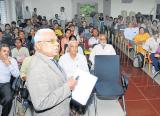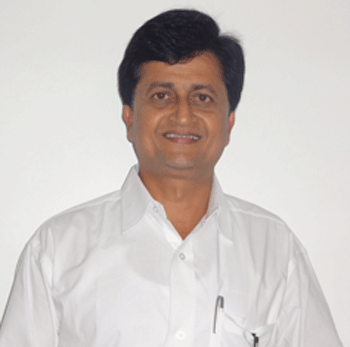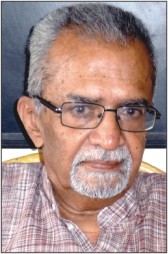
SUSHANT KULKARNI follows members of Project Meghdoot as they try to understand the monsoon by following the clouds
It is not raining. It seems as if the deep grey monsoon clouds have nothing to offer to this patch of north Karnataka, for the time being, at least. Inside a speeding minibus, a choir of 15 sing Kaale megha from Lagaan. As we come to the end of the song, a cooler breeze wafts in and the next moment the raindrops become the drum beat of the song.
The choir here is unusual, it comprises scientists, science students and meteorology-lovers who have set out on a journey to accompany the monsoon rains as they arrive in India in the first week of June and slowly proceed towards the Western Ghats. Our journey begins from Agumbe village in Karnataka, the Cherrapunji of south India, where the TV series Malgudi Days was shot. On the way, the team meets locals, studies the biodiversity of the landscape and takes weather readings to scientifically understand what the monsoon means to India.
The journey is a part of Project Meghdoot, an initiative of the Pune-based group Centre for Citizen Science and this is the third year of the activity. The aim is to gather, collate and analyse traditional knowledge about the monsoon from peoples across India and connect that with available scientific know-how.
Mayuresh Prabhune, a Pune-based freelance science journalist and researcher, who founded the group, says it is named after Kalidasa’s poem Meghadootam. “Like the yaksha who has been exiled to central India and who asks the clouds to take his message to the love of his life, who is in the Himalayas, we too travel with the cloud messengers. We meet people — fishermen, farmers, old people in villages.” He explains that Project Meghdoot consists of three teams of three or four members each; one team takes observations and readings of the biodiversity indicators of the monsoon. One tries to understand how the lives of people are affected by the monsoon by talking to people. Speaking to people provides an invaluable resource as knowledge about local climate has been accumulated over generations. Documenting these stories helps determine the long-term effect of man’s actions on the climate. And the third team focuses on taking readings of weather parameters like temperature, humidity, pressure, wind speed and direction.
In Agumbe, the group stays at the 120-year-old house of Kasturi Akka Shenai, which happens to be Swamy’s house in Malgudi Days. “The people we interviewed — most of them local villagers — told us that the rains have reduced significantly in the recent past. But the people at the local observatory in Agumbe told us that they see cycles of increasing and decreasing rain every six years. Both are important observations,” says Sumit Tambe, a member of the group who is an aerospace engineer.
Through interviews with the local police, members learned that after the onset of monsoon, the movement of Naxalite groups hiding in the jungles of the Agumbe also increases as it becomes difficult for the police to enter and comb the forests. An officer with an anti-Naxal cell of the Karnataka police says, that deployment of the police in villages increases during the monsoon.
On the picturesque mountain top named Kundadri near Agumbe, the group records the call of the Malabar whistling thrush. A group member, Spandan Waghmare says, “A particular whistle is a mating call that one hears only in the monsoons.” The same call is also recorded in Amboli, another beautiful spot in the Konkan, “The call is as melodious as a song,” says Waghmare.
Every morning, you see members of the group recording the calls of toads, frogs and crickets. Ashutosh Alekar, a zoology student says, “To us, all those noisy calls may seem alike. But in reality, the calls vary from species to species, with differences in duration of the call, the pitch and the intensity. We can also see an increase in the population of insects like ants, bugs, grasshoppers and arachnids.” All these observations are discussed during the group meetings that are held every night on the six-day tour.
From Agumbe, the group moves to Karwar in Karnataka and then reaches Goa on the fourth day. Throughout the journey, heavy rains accompany the group. On the way, they meet farmers from whom they learn that the arrival of pre-monsoon showers has shifted ahead and these areas are receiving less pre-monsoon showers. Spandan says, “In Goa the fishermen told us that they predict the arrival of the monsoon when a species of fish is seen swimming on the surface to avoid sea current and when a particular snake is spotted in the waters. We will be verifying these observations and try to find out if they have any scientific basis.”
The group is also accompanied by acclaimed Canadian filmmaker Sturla Gunnarsson, who is making a film on the monsoon. He says, “Travelling with the group was wonderful. I experienced parts of India I would never have seen otherwise, in the company of young people, optimism and scientific inquiry.” The film is about the season, as experienced by people. Gunnarsson adds, “It deals with the spectacle, the science, the cultural and spiritual dimensions of the rains. I found the project exciting as it attempts to reconcile scientific knowledge with ancient, traditional knowledge, in search for a new narrative for the subcontinent.”
In the last phase of the journey, the group comes to Mhaswad village in Sangli district of Maharashtra, an area that was badly hit by drought this summer. The group visits a camp set up during summer to provide fodder to cattle. A group member, Sneha Kulkarni says, “This part of Maharashtra receives rains mostly during two Nakshatras — the constellations that mark the time of the year — Rohini, that is the end of May and Hasta, the beginning of August. But this year, they have not received rains during Rohini. They wish there was no need for fodder camps.”
As the group readies to end their week-long journey, they pore over hundreds of photographs, dozens of weather parameter readings, and observations on biodiversity and recordings of interviews. Some of the data will also be submitted to institutes like Agharkar Research Institute and Indian Institute of Tropical Meteorology in Pune for analysis.
As the luggage is unloaded from the buses the group seems to share the thought that the monsoon can be better understood but never fully known in India.
source : http://www.indianexpress.com / The Indian Express / Home / by SushantKulkarni / New Delhi – June 30th, 2013







